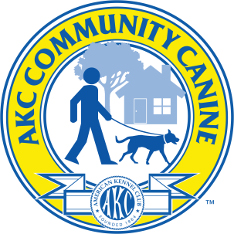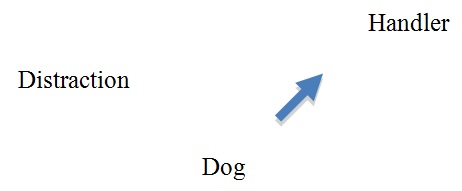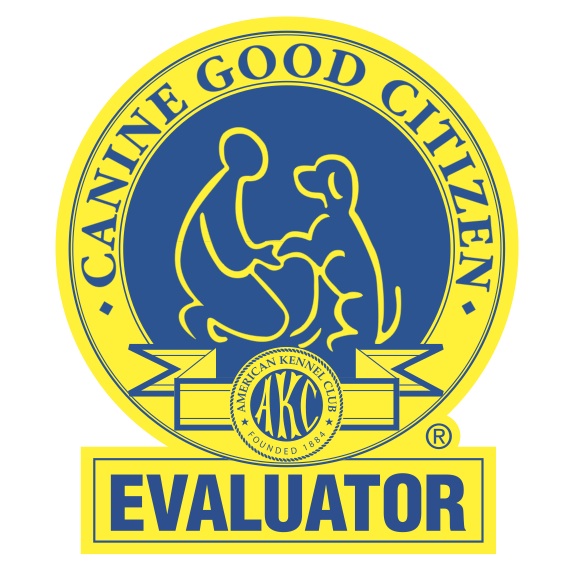|
Brochure

About AKC Community Canine -
What is AKC Community Canine?
AKC Community Canine is the advanced level of AKC's Canine Good Citizen (CGC) program.
As with CGC, AKC Community Canine has a 10-step test of skills that dogs must pass to earn the official AKC Community Canine title. This is a title that appears on the dog's title record at AKC.
The Setting
All skills on the test are tested on leash. The AKC Community Canine (CGCA) test may be done in a class, at shows, in pet stores or in the community. When the test is administered in community settings such as at a business or special event, evaluators must have the necessary approval of the business owners, etc.
While Canine Good Citizen tests are simulations of real world skills, (e.g., dog/handler walks through a "crowd" of evaluators in a ring), the goal of AKC Community Canine is to test the dog's skills in a natural setting. For example, rather than the dog being tested in a ring, in AKC Community Canine, the "walks through a crowd" test item will involve the dog walking through a real crowd at a dog show, on a busy sidewalk, in a therapy dog setting, or at a training club.
 Requirements Requirements
To earn the AKC Community Canine title, dogs must meet the following two requirements:
1. Must already have a Canine Good Citizen (CGC) award or title on record at AKC.
2. Must have an AKC number of one of 3 types (AKC registration number, PAL number, or AKC Canine Partners number). All dogs, including mixed breeds, can get an AKC number. The reason for the AKC number requirement is that this is how we create titles at AKC; we attach the titles to the dog's number. For more information on getting an AKC number, see: http://images.akc.org/cgc/number.pdf
AKC COMMUNITY CANINE TEST
Dogs must pass all 10 items of the test to receive the CGCA title.
1. Dog stands, sits or lies down and waits under control while the owner:
�sits at the registration table and fills out paperwork, or,
�if the test is done in the community, dog waits while the owner sits and has a snack or visits with
another person (e.g., at a park)
2. Walks on a loose leash in a natural situation (not in a ring)�does not pull.
�left turn
�right turn
�stop
�fast and slow pace
3. Walks on loose leash through a crowd
�at a show or in class, this item is tested in a real crowd, not in a ring
�in the community, dog walks on sidewalk, through a crowd at a community fair, park, on a trail, through a busy hallway, etc.
4. Dog walks past distraction dogs present; does not pull.
This item may be tested along with #3 if there are dogs in the crowd, etc.
�at a show or class, dog walks by dogs waiting in the crowd�dogs 2 ft. apart
�in the community, dog walks by other dogs on a trail, sidewalk, in a hallway, etc.
5. Sit�stay in small group (3 other people with dogs).
Owners and dogs are in an informal circle/square while owners have a conversation.
Dogs are all on the owner's left side, on leash; 3 ft. apart. (At least 30 seconds)
6. Dog allows person who is carrying something (backpack, computer bag, etc.) to approach and pet it.
"May I pet your dog?" (Item is placed on floor/ground before the person pets the dog)
7. "Leave it."
Dog walks by food and follows owner instructions, "Leave it."
This can be food placed by the evaluator on the floor or ground in a food dish with a wire cover as in Rally.
8. Down or sit stay�distance (owner's choice).
Dog is on 20�ft line, owner walks away with back to dog, picks up an item (e.g., backpack, training bag, clipboard, folder etc.) placed on the floor/chair/ground by the evaluator and returns to the dog.
9. Recall with distractions present (coming when called). Handler goes out 20�ft. (off center) and calls dog. Dog is on the 20�ft. line from #8 above.

10. Dog will sit or stand stay (owner's choice) while owner enters/exits a doorway or narrow passageway. Owner calls dog through door when ready.
Owner may also choose to 1) send the dog through first and have the dog wait for the owner, or 2) the owner may choose to have the dog go through the doorway at the owner's side. Whichever method is used, the dog must not pull the owner and must be under good control. Think of the handler having the leash in one hand and a cup of coffee in the other.
Doorway or gate can be real or simulated with ring gates, two chairs, or a natural passageway (e.g., entrance to trail) in the community.
If you need testing for CGC first, please contact us!
 Valerie Tillery Valerie Tillery
valerietillery@gmail.com
|